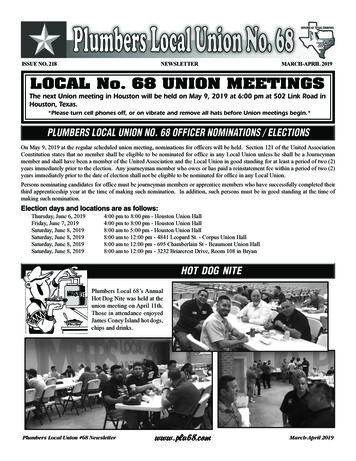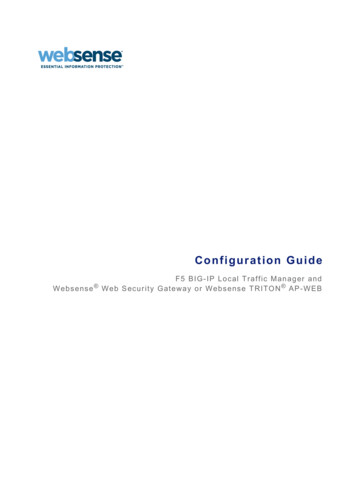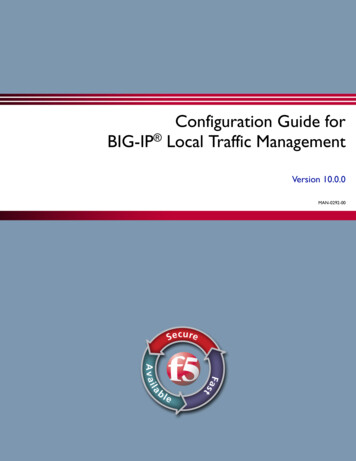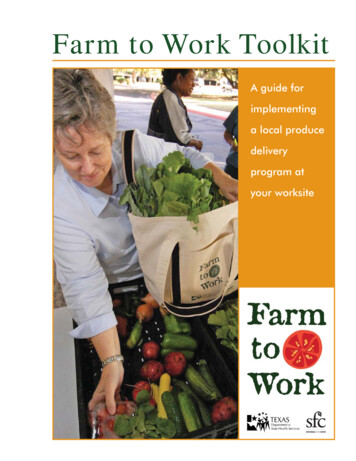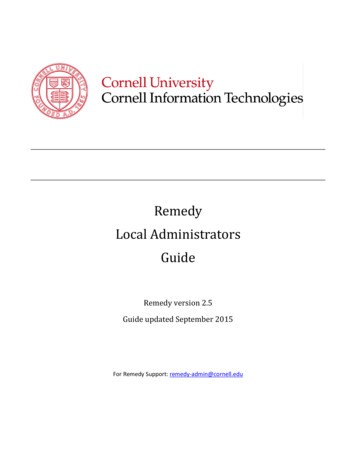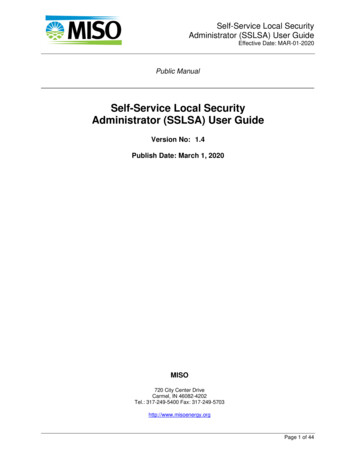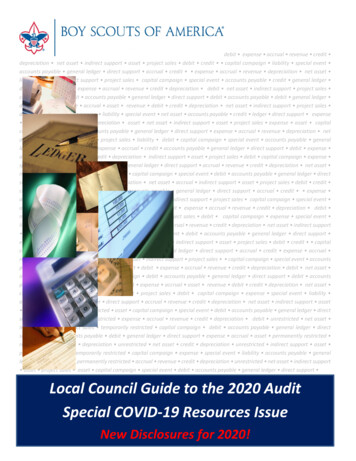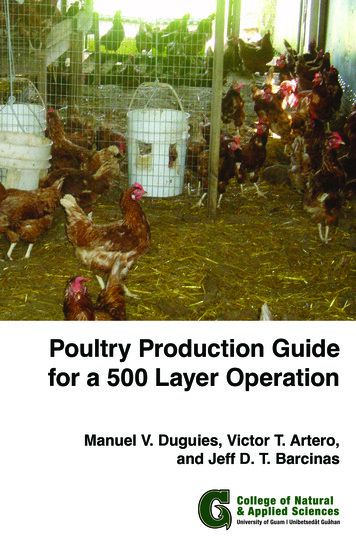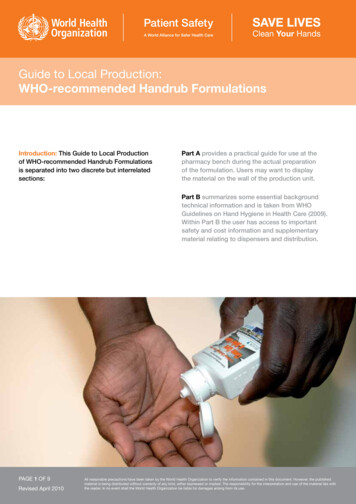
Transcription
GUIDE TO LOCAL PRODUCTION: WHO-RECOMMENDED HANDRUB FORMULATIONSGuide to Local Production:WHO-recommended Handrub FormulationsIntroduction: This Guide to Local Productionof WHO-recommended Handrub Formulationsis separated into two discrete but interrelatedsections:Part A provides a practical guide for use at thepharmacy bench during the actual preparationof the formulation. Users may want to displaythe material on the wall of the production unit.Part B summarizes some essential backgroundtechnical information and is taken from WHOGuidelines on Hand Hygiene in Health Care (2009).Within Part B the user has access to importantsafety and cost information and supplementarymaterial relating to dispensers and distribution.PAGE 1 OF 9Revised April 2010All reasonable precautions have been taken by the World Health Organization to verify the information contained in this document. However, the publishedmaterial is being distributed without warranty of any kind, either expressed or implied. The responsibility for the interpretation and use of the material lies withthe reader. In no event shall the World Health Organization be liable for damages arising from its use.
GUIDE TO LOCAL PRODUCTION: WHO-RECOMMENDED HANDRUB FORMULATIONSPART A: GUIDE TO LOCAL PRODUCTIONPart A is intended to guide a local producer in the actual preparationof the formulation.Materials required (small volume production)REAGENTS FORFORMULATION 1:REAGENTS FORFORMULATION 2: Ethanol 96% Isopropyl alcohol 99.8% Hydrogen peroxide 3% Hydrogen peroxide 3% Glycerol 98% Glycerol 98% Sterile distilled orboiled cold water Sterile distilled orboiled cold water12345678910 10-litre glass or plastic bottles with screw-threaded stoppers ( 1 ), or 50-litre plastic tanks (preferably in polypropylene or high densitypolyethylene, translucent so as to see the liquid level) ( 2 ), or Stainless steel tanks with a capacity of 80–100 litres(for mixing without overflowing) ( 3 , 4 ) Wooden, plastic or metal paddles for mixing ( 5 ) Measuring cylinders and measuring jugs ( 6 , 7 ) Plastic or metal funnel 100 ml plastic bottles with leak-proof tops ( 8 ) 500 ml glass or plastic bottles with screw tops ( 8 ) An alcoholometer: the temperature scale is at the bottomand the ethanol concentration (percentage v/v) at the top( 9 , 10 , 11 )NOTE Glycerol: used as humectant, but other emollients may be usedfor skin care, provided that they are cheap, widely availableand miscible in water and alcohol and do not add to toxicity,or promote allergy. Hydrogen peroxide: used to inactivate contaminating bacterialspores in the solution and is not an active substance forhand antisepsis. Any further additive to both formulations should be clearlylabelled and be non-toxic in case of accidental ingestion. A colorant may be added to allow differentiation from other fluids,but should not add to toxicity, promote allergy, or interfere withantimicrobial properties. The addition of perfumes or dyes isnot recommended due to risk of allergic reactions.11PAGE 2 OF 9All reasonable precautions have been taken by the World Health Organization to verify the information contained in this document. However, the publishedmaterial is being distributed without warranty of any kind, either expressed or implied. The responsibility for the interpretation and use of the material lies withthe reader. In no event shall the World Health Organization be liable for damages arising from its use.
GUIDE TO LOCAL PRODUCTION: WHO-RECOMMENDED HANDRUB FORMULATIONSMETHOD: 10-LITRE PREPARATIONSThese can be prepared in 10-litre glass or plastic bottles withscrew-threaded stoppers.Recommended amounts of products:FORMULATION 1FORMULATION 2 Ethanol 96%: 8333 ml Isopropyl alcohol 99.8%:7515 ml Hydrogen peroxide 3%: 417 ml Hydrogen peroxide 3%: 417 ml Glycerol 98%: 145 ml Glycerol 98%: 145 mlStep by step preparation:4.The bottle/tank is thentopped up to the 10-litremark with sterile distilledor cold boiled water.5.The lid or the screw capis placed on the tank/bottleas soon as possible afterpreparation, in order toprevent evaporation.2. Hydrogen peroxideis added using themeasuring cylinder.6.The solution is mixedby shaking gently whereappropriate or by usinga paddle.3.7.Immediately divide up thesolution into its final containers(e.g. 500 or 100 ml plasticbottles), and place the bottlesin quarantine for 72 hoursbefore use. This allows timefor any spores present in thealcohol or the new/re-usedbottles to be destroyed.1.The alcohol for the formulato be used is poured intothe large bottle or tank upto the graduated mark.PAGE 3 OF 9Glycerol is added using ameasuring cylinder. As glycerolis very viscous and sticks tothe wall of the measuringcylinder, it should be rinsedwith some sterile distilled orcold boiled water and thenemptied into the bottle/tank.All reasonable precautions have been taken by the World Health Organization to verify the information contained in this document. However, the publishedmaterial is being distributed without warranty of any kind, either expressed or implied. The responsibility for the interpretation and use of the material lies withthe reader. In no event shall the World Health Organization be liable for damages arising from its use.
GUIDE TO LOCAL PRODUCTION: WHO-RECOMMENDED HANDRUB FORMULATIONSFinal productsGeneral informationFORMULATION 1FORMULATION 2Final concentrations:Final concentrations: Ethanol 80% (v/v), Isopropyl alcohol 75% (v/v), Glycerol 1.45% (v/v), Glycerol 1.45% (v/v), Hydrogen peroxide0.125% (v/v) Hydrogen peroxide0.125% (v/v)Labelling should be in accordance with national guidelinesand should include the following: Name of institution WHO-recommended handrub formulation For external use only Avoid contact with eyes Keep out of the reach of children Date of production and batch numberQuality control1. Pre-production analysis should be made every time an analysiscertificate is not available to guarantee the titration of alcohol(i.e. local production). Verify the alcohol concentration withthe alcoholmeter and make the necessary adjustments involume in the preparation formulation to obtain the finalrecommended concentration.2.Post-production analysisis mandatory if either ethanolor an isopropanol solution isused. Use the alcoholmeterto control the alcoholconcentration of the finaluse solution. The acceptedlimits should be fixedto 5% of the targetconcentration (75%–85%for ethanol).3.The alcoholmeter shown inthis information pamphlet isfor use with ethanol; if usedto control an isopropanolsolution, a 75% solution willshow 77% ( 1%) on thescale at 25 C.PAGE 4 OF 9 Use: Apply a palmful of alcohol-based handrub and cover all surfacesof the hands. Rub hands until dry Composition: ethanol or isopropanol, glycerol and hydrogen peroxide Flammable: keep away from flame and heatProduction and storage facilities: Production and storage facilities should ideally be air conditionedor cool rooms. No naked flames or smoking should be permittedin these areas. WHO-recommended handrub formulations should not be producedin quantities exceeding 50-litres locally or in central pharmacieslacking specialised air conditioning and ventilation. Since undiluted ethanol is highly flammable and may ignite attemperatures as low as 10 C, production facilities should directlydilute it to the above-mentioned concentration. The flashpointsof ethanol 80% (v/v) and of isopropyl alcohol 75% (v/v) are 17.5 Cand 19 C, respectively. National safety guidelines and local legal requirements mustbe adhered to the storage of ingredients and the final product. Additional safety information is presented in Part B of this Guide.All reasonable precautions have been taken by the World Health Organization to verify the information contained in this document. However, the publishedmaterial is being distributed without warranty of any kind, either expressed or implied. The responsibility for the interpretation and use of the material lies withthe reader. In no event shall the World Health Organization be liable for damages arising from its use.
GUIDE TO LOCAL PRODUCTION: WHO-RECOMMENDED HANDRUB FORMULATIONSPART B: SUPPLEMENTARY TECHNICAL,SAFETY AND COST INFORMATION:Part B contains important safety and cost information andincorporates information from the WHO Guidelines onHand Hygiene in Health Care (2009).EfficacyIt is the consensus opinion of a WHO expert group that WHOrecommended handrub formulations can be used both for hygienichand antisepsis and for presurgical hand preparation.Hygienic handrubThe case for alcohol-based handrubsin health careAt present, alcohol-based handrubs are the only known meansfor rapidly and effectively inactivating a wide array of potentiallyharmful microorganisms on hands.WHO recommends alcohol-based handrubs based onthe following factors:1. Evidence-based, intrinsic advantages of fast-acting andbroad-spectrum microbicidal activity with a minimal riskof generating resistance to antimicrobial agents;2. Suitability for use in resource-limited or remote areas withlack of accessibility to sinks or other facilities for hand hygiene(including clean water, towels, etc.);3. Capacity to promote improved compliance with hand hygieneby making the process faster, more convenient and immediatelyaccessible at the point of patient care;4. Economic benefit by reducing annual costs for hand hygiene,representing approximately 1% of extra-costs generated byhealth care-associated infection5. Minimization of risks from adverse events because of increasedsafety associated with better acceptability and tolerance thanother products.(Source: WHO Guidelines on Hand Hygiene in Health Care 2009)Background to WHO alcohol-basedhandrub formulationsAccording to the available evidence on efficacy, tolerability and costeffectiveness, WHO recommends using an alcohol-based handrub forroutine hand antisepsis in most clinical situations. Health-care facilitiescurrently using commercially-available handrubs, liquid soaps andskin care products sold in disposable containers should continue thispractice, provided that the handrubs meet recognised standards formicrobicidal efficacy (ASTM or EN standards) and are well accepted/tolerated by the health-care workers. It is obvious that these productsshould be regarded as acceptable, even if their contents differ fromthose of WHO-recommended formulations described within thisdocument. WHO recommends the local production of the followingformulations as an alternative when suitable commercial products areeither unavailable or too costly.The microbicidal activity of the two WHO-recommended formulationswas tested by WHO reference laboratories according to EN standards(EN 1500). Their activity was found to be equivalent to the referencesubstance (isopropanol 60% v/v) for hygienic hand antisepsis.Presurgical hand preparationBoth WHO-recommended handrub formulations were tested by twoindependent reference laboratories in different European countriesto assess their suitability for use for pre-surgical hand preparation,according to the European Standard EN 12791. Although formulationI did not pass the test in both laboratories and formulation II in onlyone of them, the expert group is, nevertheless, of the opinion that themicrobicidal activity of surgical antisepsis is still an ongoing issue forresearch as due to the lack of epidemiological data there is no indicationthat the efficacy of n-propanol (propan-1-ol) 60% v/v as a referencein EN 12791 finds a clinical correlate. It is the consensus opinion of aWHO expert group that the choice of n-propanol is inappropriate asthe reference alcohol for the validation process because of its safetyprofile and the lack of evidence-based studies related to its potentialharmfulness for humans. Indeed, only a few formulations worldwidehave incorporated n-propanol for hand antisepsis.Considering that other properties of WHO recommended formulations,such as their excellent tolerability, good acceptance by health-careworkers and low cost are of high importance for a sustained clinicaleffect, the above results are considered acceptable and it is theconsensus opinion of a WHO expert group that the two formulations canbe used for surgical hand preparation. Institutions opting to use WHOrecommended formulations for surgical hand preparation should ensurethat a minimum of three applications are used, if not more, for a periodof 3–5 minutes. For surgical procedures of more than 2 hours duration,ideally surgeons should practise a second handrub of approximately 1minute, even though more research is needed on this aspect.Key lessons learned from around the worldMany settings around the world successfully undertook local productionof the two WHO-recommended formulations. Throughout Part B,additional information is presented where relevant, in table form, basedon feedback from 11 sites located in Bangladesh, Costa Rica, Egypt,Hong Kong SAR, Kenya, Mali, Mongolia, Pakistan (two sites), SaudiArabia, and Spain. Further, detailed information is available withinthe WHO Guidelines on Hand Hygiene in Health Care (2009)To help countries and health-care facilities to achieve system changeand adopt alcohol-based handrubs, WHO has identified formulationsfor their local preparation. Logistic, economic, safety, cultural andreligious factors have all been carefully considered by WHO beforerecommending such formulations for use worldwide.PAGE 5 OF 9All reasonable precautions have been taken by the World Health Organization to verify the information contained in this document. However, the publishedmaterial is being distributed without warranty of any kind, either expressed or implied. The responsibility for the interpretation and use of the material lies withthe reader. In no event shall the World Health Organization be liable for damages arising from its use.
GUIDE TO LOCAL PRODUCTION: WHO-RECOMMENDED HANDRUB FORMULATIONSComposition of alcohol-based formulations forin-house/local productionThe choice of components for WHO handrubs takes into accountboth cost constraints and microbiological efficacy. The procurementof raw ingredients will be influenced by the availability of sub-standardmaterials on the market and it is important to select local sourceswith care.Raw materials:While alcohol is the active component in the formulations, certainaspects of other components should be respected. All raw materialsused should be preferably free of viable bacterial spores. The rawmaterials for inclusion/consideration are listed in the table below:H2O2The following two alcohol-based handrub formulations arerecommended for preparation in-house or in a local productionfacility, up to a maximum of 50 litres: H2O2 adds an important safety aspect, howeverthe use of 3–6% for the production might becomplicated by its corrosive nature and bydifficult procurement in some countries.Formulation 1To produce final concentrations of ethanol 80% v/v, glycerol1.45% v/v, hydrogen peroxide (H2O2) 0.125% v/v. Further investigation is needed to assess H2O2availability in different countries as well as thepossibility of using a stock solution with a lowerconcentration.Formulation 2To produce final concentrations of isopropyl alcohol 75% v/v,glycerol 1.45% v/v, hydrogen peroxide (H2O2) 0.125% v/v:Only pharmacopoeial quality reagents should be used (e.g. TheInternational Pharmacopoeia) and not technical grade products. The low concentration of H2O2 is intended tohelp eliminate contaminating spores in thebulk solutions and recipients and is not an activesubstance for hand antisepsis.Glyceroland otherhumectantsor emollients Glycerol is added as a humectant to increasethe acceptability of the product. Other humectants or emollients may be usedfor skin care, provided that they are affordable,available locally, miscible (mixable) in water andalcohol, non-toxic, and hypoallergenic. Glycerol has been chosen because it is safe andrelatively inexpensive. Lowering the percentageof glycerol may be considered to further reducestickiness of the handrub.Use ofproperwater While sterile distilled water is preferred formaking the formulations, boiled and cooledtap water may also be used as long as it is freeof visible particules.Additionof otheradditives It is strongly recommended that no ingredientsother than those specified here be added tothe formulations. In the case of any additions, full justification mustbe provided together with documented safetyof the additive, its compatibility with the otheringredients, and all relevant details should begiven on the product label.Gellingagents No data are available to assess the suitabilityof adding gelling agents to WHO-recommendedliquid formulations, but this could increasepotentially both production difficulties and costs,and may compromise antimicrobial efficacy.Fragrances The addition of fragrances is not recommendedbecause of the risk of allergic reactions.All handrub containers must be labelled in accordance with nationaland international guidelines.PAGE 6 OF 9All reasonable precautions have been taken by the World Health Organization to verify the information contained in this document. However, the publishedmaterial is being distributed without warranty of any kind, either expressed or implied. The responsibility for the interpretation and use of the material lies withthe reader. In no event shall the World Health Organization be liable for damages arising from its use.
GUIDE TO LOCAL PRODUCTION: WHO-RECOMMENDED HANDRUB FORMULATIONSProcurement of components: key learning from around the world(based on feedback from the field)EthanolCleansing and disinfection process for reusablehandrub bottles:Easier to procure from local suppliers due tocost in some countries.1. Bring empty bottles to a central point for reprocessingby standard operational protocols; Can be derived from sugar cane or wheat.2. Wash bottles thoroughly with detergent and tap waterto eliminate any residual liquid; Subject to licensing restrictions and strictrecord-keeping – an important considerationprior to embarking on production.IsopropylEasier to procure in some countries.GlycerolProduced by local suppliers in most cases.Hydrogen peroxideDifficulties sourcing satisfactory H2O2 resultedin the need to import in five sites.Production and storageManufacture of WHO-recommended handrub formulations is feasible incentral pharmacies or dispensaries. Whenever possible and according tolocal policies, governments should encourage local production, supportthe quality assessment process, and keep production costs as low aspossible. Special requirements apply for the production and stock pilingof the formulations, as well as for the storage of the raw materials.Because undiluted ethanol is highly flammable and may ignite attemperatures as low as 10 C, production facilities should directly dilute itto the concentrations detailed within this guide. (Refer to Summary tableof risks and mitigation measures concerning the use of alcohol-basedhand hygiene preparations)WHO is exploring the development of additional guidance on large-scaleproduction to facilitate scale-up.Production facilities and personnel: key learning from around theworld (based on feedback from the field)Who are themain producers? Qualified pharmacists.How much is produced? 10 litres to 600,000 litres permonth was produced in test-sites.Where doesproduction occur? Hospital pharmacy.Production equipment Plastic, stainless steel and glasscontainers were used for mixing.Dispensers forfinal product Ranges used:3. If heat-resistant, thermally disinfect bottles by boiling in water.Whenever possible, thermal disinfection should be chosen inpreference to chemical disinfection. The latter may increasecosts and introduces an extra step to flush out the remains ofthe disinfectant. Chemical disinfection should include soaking thebottles in a solution containing 1000 ppm of chlorine for a minimumof 15 minutes and then rinsing with sterile/cooled boiled water;4. After thermal or chemical disinfection, leave bottles to drycompletely upside-down in a bottle rack. Dry bottles shouldbe closed with a lid and stored, protected from dust, until use.Quality Control:If concentrated alcohol is obtained from local production, verify thealcohol concentration and make the necessary adjustments in volumeto obtain the final recommended concentration. An alcoholmeter canbe used to control the alcohol concentration of the final use solution;H2O2 concentration can be measured by titrimetry (oxydo-reductionreaction by iodine in acidic conditions). A higher level quality controlcan be performed using gas chromatography and the titrimetricmethod to control the alcohol and the hydrogen peroxide content,respectively. Moreover, the absence of microbial contamination(including spores) can be checked by filtration, according to theEuropean Pharmacopeia specifications.Quality control: key learning from around the world(based on feedback from the field)Method Seven sites sent samples to theUniversity of Geneva Hospitals,Geneva, Switzerland, for qualitychecks by gas chromatographyand the titrimetric method tocontrol the alcohol and thehydrogen peroxide content. National drug companies.– 100 ml pocket bottles– 385 ml bottlesAddition of fragrance Quality was optimal for threeformulations in which either afragrance or special humectantswere added to WHO formulation I.Extremes of climate Samples from Mali, which werekept in a tropical climate withoutair conditioning or special ventilation,were in accordance with the optimalquality parameters in all samplesup to 19 months after production.– 500 ml wall-mounted dispensers– 1 litre wall mounted bottlesor bagsSources of dispensers Local sourcing can proveproblematic, some countrieshad success working withlocal private sector suppliers. Local alcoholmeters used inmajority of sites.Storage volumes:Special requirements are applicable for the production and storageof the formulations, as well as the storage of the primary products.The quantity of locally-produced WHO handrub should not exceed50 litres, or possibly less if regulated by local and/or nationalguidelines and regulations.PAGE 7 OF 9All reasonable precautions have been taken by the World Health Organization to verify the information contained in this document. However, the publishedmaterial is being distributed without warranty of any kind, either expressed or implied. The responsibility for the interpretation and use of the material lies withthe reader. In no event shall the World Health Organization be liable for damages arising from its use.
GUIDE TO LOCAL PRODUCTION: WHO-RECOMMENDED HANDRUB FORMULATIONSDistributionSafety StandardsTo avoid contamination with spore-forming organisms, disposablebottles should preferably be used although reusable sterilizable bottlesmay reduce production costs and waste management. To preventevaporation, containers should have a maximum capacity of 500 ml onward and 1 litre in operating theatres, and ideally fit into a wall dispenser.Leakage-free pocket bottles with a capacity of no more than 100 mlshould also be available and distributed individually to health-careworkers, but it should be emphasized that the use of these productsshould be confined to health care only. The production or re-filling unitshould follow norms on how to clean and disinfect the bottles (e.g.autoclaving, boiling, or chemical disinfection with chlorine). Autoclavingis considered the most suitable procedure. Reusable bottles shouldnever be refilled until they have been completely emptied and thencleansed and disinfected.With regard to skin reactions, handrubbing with alcohol based solutionsis better tolerated than handwashing with soap and water. In a recentstudy conducted among ICU health-care workers, the short-termskin tolerability and acceptability of WHO-recommended handrubformulations were significantly higher than those of a reference product.Any additive should be as non-toxic as possible in case of accidental orintentional ingestion.Cleaning and recycling: key learning from around the world(based on feedback from the field)Cleaning and recyclingof dispensers The cleaning and recycling processoutlined in this document was appliedin six sites. Methods used fordisinfection varied and includedtreatment with chlorine or alcohol.Cost issues:The costs of WHO handrub formulations may vary according to country,resources and labour costs; studies to evaluate costs and resourceuse are necessary. As a comparison, examples of actual prices ofcommercially available alcohol-based handrubs in different countriesare detailed within the Guidelines.Costs: Key learning from around the world (based on feedbackfrom the field)Production cost (includingsalaries but not the dispenser)per 100 mlFormulation 1: US 0.37 (Kenya) US 0.30 (Mali)Formulation 2: US 0.30 (Bangladesh).Production cost (includingthe pocket bottle) per 100 mlFormulation 1: US 0.50 (Hong Kong)Formulation 2: US 0.44 (Pakistan)Range of cost of commerciallyavailable products per 100 mlPAGE 8 OF 9 US 2.50–5.40 (liquid) US 8 (gel)General Safety Issues:The main safety issues relate to the flammability of alcohol-basedhandrubs and the adverse effects associated with accidental ordeliberate ingestion. These are summarised in the Summary table ofrisks and mitigation measures concerning the use of alcohol-basedhand hygiene preparations.Flammability – Flash-points:The flash points of ethanol 80% (v/v) and isopropyl alcohol 75% (v/v)are 17.5 C and 19 C, respectively, and special attention should begiven to proper storage in tropical climates. Production and storagefacilities should be ideally air-conditioned or cool rooms. Open flamesand smoking must be strictly prohibited in production and storageareas. Pharmacies and small-scale production centres supplying WHOrecommended handrub formulations are advised not to manufacturelocally batches of more than 50 litres at a time.Accidental ingestion:In general, it is not recommended to add any bittering agents to reducethe risk of ingestion of the handrubs. Nevertheless, in exceptional caseswhere the risk of ingestion might be very high (paediatric or confusedpatients), substances such as methylethylketone and denatoniumbenzoate, added to some household products to make them lesspalatable, may be added to alcohol-based handrubs in order to reducethe risk of accidental or deliberate ingestion. However, there is nopublished information on the compatibility and deterrent potential ofsuch chemicals when used in alcohol-based handrubs to discouragetheir abuse. It is important to note that such additives may make theproducts toxic and add to production costs. In addition, the bitter tastemay be transferred from hands to food being handled by individualsusing handrubs containing such agents. Therefore, compatibility andsuitability, as well as cost, must be carefully considered before decidingon the use of such bittering agents.A colorant may be incorporated to differentiate the handrub fromother fluids as long as such an additive is safe and compatible withthe essential components of the handrubs. However, the H2O2 inthe handrubs may tend to fade any colouring agent used and priortesting is recommended.All reasonable precautions have been taken by the World Health Organization to verify the information contained in this document. However, the publishedmaterial is being distributed without warranty of any kind, either expressed or implied. The responsibility for the interpretation and use of the material lies withthe reader. In no event shall the World Health Organization be liable for damages arising from its use.
GUIDE TO LOCAL PRODUCTION: WHO-RECOMMENDED HANDRUB FORMULATIONSSummary table of risks and mitigation measuresconcerning the use of alcohol-based handhygiene preparationsRiskMitigationRiskMitigationFire – general Do not produce in quantities exceeding 50litres locally. If producing in excess of 50 litres,produce only in central pharmacies withspecialized air conditioning and ventilation.Fire – storage(local) The quantity of handrub kept in a ward ordepartment should be as small as is reasonablypracticable for day-to-day purposes.Fire – disposal Rinse out used containers with copiousamounts of cold water to reduce the risk offire (the containers may then be recycled ordisposed of in general waste).Fire – locationof dispensers Handrub dispensers should not be placedabove or close to potential sources of ignition,such as light switches and electrical outlets,or next to oxygen or other medical gasoutlets (because of the increased risk ofvapours igniting).Fire – spillage Significant spillages should be dealt withimmediately by removing all sources of ignition,ventilating the area, and diluting the spillagewith water (to at least 10-times the volume). Since undiluted ethanol is highly flammableproduction facilities should directly dilute it tothe concentrations outlined in this Guide. Involve fire officers, fire safety advisers, riskmanagers, and health and safety and infectioncontrol professionals in risk assessments priorto embarking on system change Risk assessment should take into account:– The location of dispensers– The storage of stock– The disposal of used containers/dispensers and expired stock. Store away from high temperatures or flames The fluid should then be absorbed by an inertmaterial such as dry sand (not a combustiblematerial such as sawdust), which should bedisposed of in a chemical waste container. Water or aqueous (water) film-forming foam(AFFF) should be used in case of fire; othertypes of extinguishers may be ineffective andmay spread the fire over a larger area ratherthan put it out. Vapours should be dispersed by ventilatingthe room (or vehicle), and the contaminateditem should be put in a plastic bag until it canbe washed and/or dried safely. Health-care workers should be advised torub hands until dry
GUIDE TO LOCAL PRODUCTION: WHO-RECOMMENDED HANDRUB FORMULATIONS All reasonable precautions have been taken by the World Health Organization
